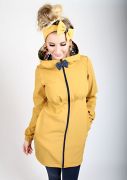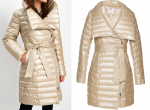Size charts What is the height of the pattern Payment methods Ask a question Reviews
PDF pattern for printing on a printer or plotter in full size for robe coat sizes from 40 to 52.
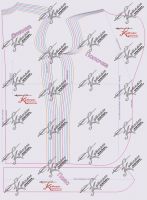 Sizes: 40-52 (buyer gets ALL sizes!).
Sizes: 40-52 (buyer gets ALL sizes!).
File format for download in order:
PDF in full size and without seam allowances.
After paying for the order, you will receive links to download two files coat patterns gradation sizes from 40 to 52:
- PDF file A4, adapted for printing patterns on sheets of A4 paper in any program on any device, including mobile phones.
- Multi-format PDF file for printing on sheets of any size from A0 to A4 on a printer or plotter using Adobe Reader.
 Sewing difficulty level: professional, that is, the pattern for beginners is not suitable. With the seeming simplicity of the style for sewing a coat of a couturier's robe, professional skills will be needed to process the sides and collar of the English type, as well as to sew in the sleeve and connect the "top" with the lining.
Sewing difficulty level: professional, that is, the pattern for beginners is not suitable. With the seeming simplicity of the style for sewing a coat of a couturier's robe, professional skills will be needed to process the sides and collar of the English type, as well as to sew in the sleeve and connect the "top" with the lining.
This style of robe coat is only suitable for slender girls and women.
The consumption of the “top” fabric is, depending on the size, 250–260 cm with a width of 140 cm. The consumption of the lining is 150–160 cm. .
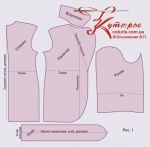 In addition to fabric and dubbing, you will need epaulette shoulder pads and a mannequin.
In addition to fabric and dubbing, you will need epaulette shoulder pads and a mannequin.
For sewing a coat, it is advisable to choose soft and not too thick fabrics. Tweed, half-drape, not too thick bouclé or cashmere are ideal.
There are no special requirements for lining fabrics, except for wear resistance and good glide.
The set of patterns for a coat-robe includes (Fig. 1): back, shelf, sleeve, collar and belt.
The lining and lining are cut out according to the same patterns. See below for cutting and sewing details.
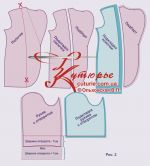 How to buy an electronic pattern
How to buy an electronic pattern
How to print a pattern life-size at home on A4 sheets
How to choose a pattern size without taking measurements and using tables
Download free patterns of dresses and coats for children
 How to cut a robe coat at home
How to cut a robe coat at home
(detailed description with sequence)
First, let's figure out how to cut the collar and lining according to the patterns of the "top" of the coat (Fig. 2).
 For convenient cutting, make a duplicate of the shelf pattern and cut it. The cut line should not be straight. The indent from the neck is 5 - 6 cm.
For convenient cutting, make a duplicate of the shelf pattern and cut it. The cut line should not be straight. The indent from the neck is 5 - 6 cm.
And immediately about allowances: we add 1 - 1,2 cm for thin fabrics and 1,2 - 1,5 cm, that is, 0,2 - 0,5 cm more than along the edge cut of the bead.
For the lining of the shelf, the differences are only in the allowance for the cut of the connection with the side - it is double.
 As for the sleeve with a lapel, it is important to immediately determine the length of the sleeve and the width of the lapel in finished form. And since the coat-robe model has a lowered shoulder, this somewhat complicates the task.
As for the sleeve with a lapel, it is important to immediately determine the length of the sleeve and the width of the lapel in finished form. And since the coat-robe model has a lowered shoulder, this somewhat complicates the task.
To compare lengths, use the measure Dp + Dr.
When the finished sleeve length is determined, add the finished lapel width plus 1 cm to it.
For lining a sleeve with a lapel, the width of the lapel minus 1 cm should be subtracted from the length of the sleeve. You can also lay a small overlap of the lining - 1,5 - 2 cm.
Further. Consider how to duplicate an unlined robe coat (fig. 3) and how to duplicate a lined robe coat (fig. 3 - 4).
Duplication of the product without lining (Fig. 3) - lapel to the fold line, collar and collars.
In a lined coat (Fig. 4), the front is duplicated completely, the back to the level of the shoulder blades, the hem, collars. But, if there is a belt, you can duplicate the shelf as well as the back (Fig. 3). The choice of option depends on the stiffness and density of dublerin and on the properties of the fabric.
Let's focus on the lapel separately. A pressed lapel requires a gap of 0,5 cm in the dubbing of the shelf exactly along the line of inflection. Swinging lapel - no, the dubbing is solid.
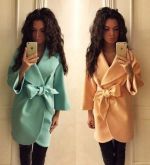 Of course, in any case, the allowances of the bottom of the coat and the sleeve are duplicated if the sleeve is without a lapel. Pay attention to the ledge at the bottom of the shelf, where the rounding ends. It is important that this ledge not only reaches the edge, but also overlaps it by 2 cm - this is necessary for clean processing.
Of course, in any case, the allowances of the bottom of the coat and the sleeve are duplicated if the sleeve is without a lapel. Pay attention to the ledge at the bottom of the shelf, where the rounding ends. It is important that this ledge not only reaches the edge, but also overlaps it by 2 cm - this is necessary for clean processing.
Cutting the robe coat itself is not difficult - the seam allowances are common for coats with an English type collar.
On fig. 4 shows a cut from a lint-free fabric such as boucle or tweed. When cutting a coat made of fabric with pile, the direction of the pile should be taken into account.
A few words about the shared thread.
The front hem in English collars should be parallel to the edge of the lapel, but in a lapel of this shape it is difficult to determine such a parallel, so we place the hem approximately in this direction.
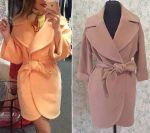 The lower collar in English collars has a shared parallel line of the rake. In “English type” collars, it is enough to place the pattern on the fabric in such a way that the middle line of the lower collar does not fall on either the lobar or the transverse thread. At the top collar, of course, the lobar is parallel to the midline, while the classic assumes the lobar is parallel to the ends of the collar.
The lower collar in English collars has a shared parallel line of the rake. In “English type” collars, it is enough to place the pattern on the fabric in such a way that the middle line of the lower collar does not fall on either the lobar or the transverse thread. At the top collar, of course, the lobar is parallel to the midline, while the classic assumes the lobar is parallel to the ends of the collar.
When cutting a sleeve that has only an elbow seam, it is important that the cuts of this seam do not coincide with the share direction - pay attention to the share pointer on the sleeve pattern.
But it is advisable to cut the belt along the shared thread, since it is important that the belt does not stretch in the sock, otherwise the lines will burst.
The lining (fig. 5) is cut out very simply.
In this model, you can safely cut out a one-piece back without a seam, and lay the sleeve across. At the same time, to save money, the fabric should be folded along the width of the layout, and from the resulting residue, cut out the burlap of pockets.
Burlap size:
width = pocket width in finished form + 5 cm;
burlap length = double pocket depth when finished + 4 cm.
The shape of the burlap is corrected already when sewing pockets.
The sewing sequence for the robe coat is exactly the same as the sewing sequence for other coats.
Download this pattern pdf:
Pattern "coat-robe"
$2.50 (100 hryvnia)
Bank cards of the Russian Federation are not accepted for payment!
Size charts What is the height of the pattern Payment methods Ask a question Reviews
Vera Olkhovskaya in social networks:

-
Any pattern for free for a review of a previously made order
More...
Lifetime promotion for buyers of patterns!

Leave a review about my store of patterns for an order that you made before, and you will receive any paid pattern of your choice Free!


